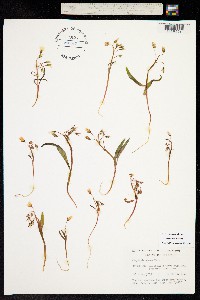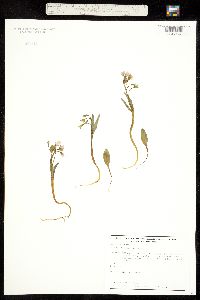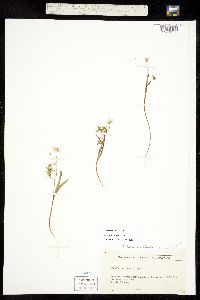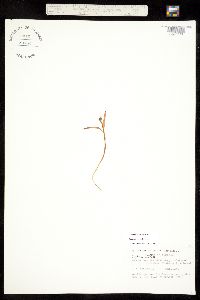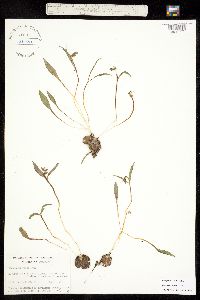Claytonia rosea
|
|
|
|
Family: Montiaceae
western springbeauty
[Claytonia lanceolata var. rosea (Rydb.) R.J. Davis] |
See species description for more details. LEAVES: Basal leaves 1-2, attached to corm, ovate to lanceolate, 3.1-13.8 cm long, 0.6-1.8 cm wide. INFLORESCENCE: subtended by a leafy bract with minute upper bracts in the inflorescense reduced to membraneous scales. FLOWER: petals 5-16 mm long. DISTRIBUTION: Ponderosa pine and pinyonjuniper forests, in moist soil, often near the Mogollon Rim: Cochise, Coconino, Gila, Maricopa, Mohave, Navajo, Yavapai cos.; 1300-2300 m (4200-7500 ft); Feb-May; CO, MT, NM, UT, w Can. Notes: The Arizona specimens are here all referred to Claytonia lanceolata var. rosea. In some recent floristic treatments (Weber 1990, Miller 2003) this taxon is recognized as C. rosea and separated from C. lanceolata based on the presence of basal leaves (vs. absent in C. lanceolata), multiple minute bractlets within the inflorescence (vs. bractlets absent in C. lanceolata), and petal length 8-10 mm (vs. 5-20 mm in C. lanceolata). Of these three characters, only the presence of basal leaves distinguishes the Arizona specimens as a distinct taxon, recognized here as a geographical variety. Basal leaves originate from the corm, so when the corm is absent from herbarium specimens the basal leaves are absent or disconnected. Thus lack of basal leaves is often a reflection of the quality of the collection (i.e., whether the specimen was dug up vs. pulled up). Out of the 32 specimens examined that had corms, only 4 were missing basal leaves. Claytonia lanceolata var. rosea needs experimental work to substantiate its recognition at the specific level. REFERENCES: Allison Bair, Marissa Howe, Daniela Roth, Robin Taylor, Tina Ayers, and Robert W. Kiger., 2006, Vascular Plants of Arizona: Portulacaceae. CANOTIA 2(1): 1-22. Plants perennial, with globose tubers 20-100 mm; periderm 5-10 mm. Stems 2-15 cm. Leaves: basal leaves sometimes absent, petiolate, blade linear to narrowly spatulate, 1-7 × 0.4-2 cm, apex acute to obtuse; cauline leaves petiolate, blade linear, 2-5 cm, apex acute to obtuse. Inflorescences multibracteate, rarely 1-bracteate; proximalmost bract leaflike, distal bracts reduced to membranous scales. Flowers 8-14 mm diam.; sepals 3-5 mm; petals pink, rose, or magenta, 8-10 mm; ovules 6. Seeds 2-3 mm, shiny and smooth; elaiosome 1-2 mm. 2n = 16. Flowering Feb-May. Hillsides and mesas of montane ponderosa and Chihuahuan pine and oak belts; 800-2400 m; Ariz., Colo., N.Mex., Utah; Mexico. Claytonia rosea is morphologically distinct from C. lanceolata based on early cytological and ecological study of the two species by D. K. Halleck and D. Wiens (1966) and the author´s review of type material.
General: Perennial, 2-15 cm tall; stems 1 to several, slender; herbage glabrous, more-or-less fleshy; plants arising from globose tubers. Leaves: Basal (sometimes absent) and cauline, opposite, the basal blades linear to narrowly spatulate, 1-7 cm long, 4-20 mm wide, the cauline blades linear, 2-5 cm long; basal and cauline blades petiolate. Flowers: Inflorescence terminal, narrowly panicle-like, dense; pedicels filiform, 6-16 mm long; flowers arranged in whorls; perianth campanulate, greenish, pinkish, or reddish brown, the inner tepals ovate-triangular to sub- cordate, 5-6 mm long, widest near the middle, abruptly contracted at the apex, margins entire, minutely and indistinctly dentate, mostly at the base; tubercles absent; flowers May-June. Fruits: Capsule ovoid, about 4 mm long, 3-valved; seeds shiny, smooth. Ecology: Oak and pine woodlands, ponderosa pine forests, montane habitats; 1400-2300 m (4500-7500 ft); Cochise, Coconino, Gila, Graham, Greenlee, Maricopa, Pima, Pinal, Santa Cruz, and Yavapai counties; southwestern U.S., Mexico. Notes: Claytonia perfoliata (miner-s lettuce) [=Montia perfoliata] is an annual, 5-50 cm tall; basal blades are erect or nearly so in rosettes, rhombic, deltate, or kidney-shaped, 1-7 cm long; cauline blades are perfoliate, cleft, or notched, mostly 1-3 cm in diameter; inflorescence is a raceme, subtended by one bract, this leaf-like; flowers are 3-10 mm long, with pink to white petals. Three ssp. apparently occur within our range: ssp. intermontana, ssp. mexicana, and ssp. perfoliata. Editor: Springer et al. 2008 |
|
|
|
































